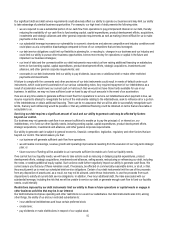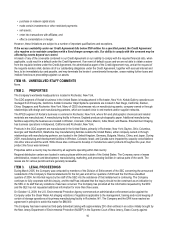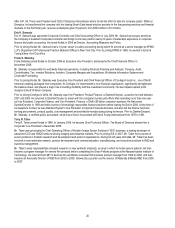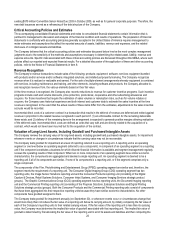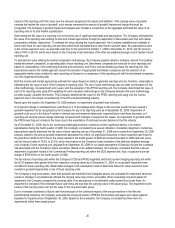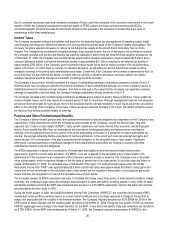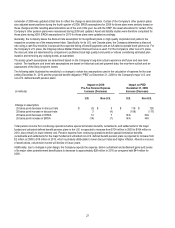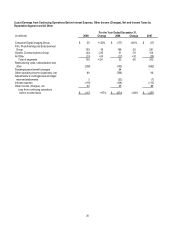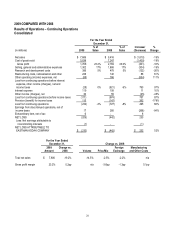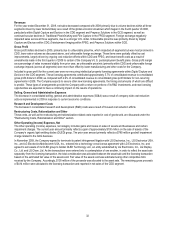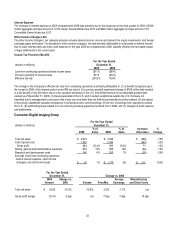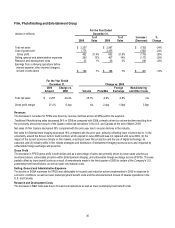Kodak 2009 Annual Report Download - page 27
Download and view the complete annual report
Please find page 27 of the 2009 Kodak annual report below. You can navigate through the pages in the report by either clicking on the pages listed below, or by using the keyword search tool below to find specific information within the annual report. 25
excess of the reporting unit’s fair value over the amounts assigned to the assets and liabilities. If the carrying value of goodwill
exceeds the implied fair value of goodwill, such excess represents the amount of goodwill impairment charge that must be
recognized. The Company’s goodwill impairment analysis also includes a comparison of the aggregate estimated fair value of all
reporting units to its total market capitalization.
Determining the fair value of a reporting unit involves the use of significant estimates and assumptions. The Company estimates the
fair value of its reporting units utilizing income and market approaches through the application of discounted cash flow and market
comparable methods, respectively. To estimate fair value utilizing the income approach, the Company established an estimate of
future cash flows for each reporting unit and discounted those estimated future cash flows to present value. Key assumptions used
in the income approach were: (a) expected cash flow for the period from October 1, 2009 to December 31, 2014; and (b) discount
rates of 16% to 26.5%, which were based on the Company’s best estimates of the after-tax weighted-average cost of capital of each
reporting unit.
To estimate fair value utilizing the market comparable methodology, the Company applied valuation multiples, derived from publicly-
traded benchmark companies, to operating data of each reporting unit. Benchmark companies are selected for each reporting unit
based on comparability of the underlying business and economics, and if they could potentially purchase the reporting unit. Key
assumptions used in the market approach include the selection of appropriate benchmark companies and the selection of an
appropriate market value multiple for each reporting unit based on a comparison of the reporting unit with the benchmark companies
as of the impairment testing date.
Both the income and market approaches estimate fair values based on ability to generate earnings and are, therefore, meaningful in
estimating the fair value of each of the Company’s reporting units. The use of each methodology also provides corroboration for the
other methodology. Consistent with prior years, with the exception of the FPEG reporting unit, the Company determined fair value of
each of its reporting units using 50% weighting for each valuation methodology as the Company believes that each methodology
provides equally valuable information. The Company determined fair value for the FPEG reporting unit using only the income
approach due to the unique circumstances of the film and photofinishing industry.
Based upon the results of its September 30, 2009 analysis, no impairment of goodwill was indicated.
A 20 percent change in estimated future cash flows or a 10 percentage point change in discount rate would not have caused a
goodwill impairment to be recognized by the Company for any of its reporting units as of September 30, 2009. Impairment of
goodwill could occur in the future if market or interest rate environments deteriorate, expected future cash flows decrease, or if
reporting unit carrying values change materially compared with changes in respective fair values. An impairment of goodwill within
the FPEG reporting unit is likely in the future due to the expectation of continued secular declines in the film industry.
As of December 31, 2008, due to the continuing challenging business conditions and the significant decline in its market
capitalization during the fourth quarter of 2008, the Company concluded there was an indication of possible impairment. Certain key
assumptions used to determine the fair value of each reporting unit as of December 31, 2008 were revised from September 30, 2008
analysis related to the annual goodwill impairment assessment to reflect: (a) significant reductions in future expected cash flows for
the period from 2009 to 2013 due to the actual results for the fourth quarter of 2008 and revised forecasts for 2009 and later years;
and (b) discount rates of 18.5% to 23.0%, which were based on the Company’s best estimates of the after-tax weighted-average
cost of capital of each reporting unit, adjusted from September 30, 2008 for our latest assessment of financial risk and the increased
risk associated with the Company’s future operations. Based on its updated analysis, the Company concluded that there was an
impairment of goodwill related to the Commercial Printing reporting unit within the GCG segment and, thus, recognized a pre-tax
charge of $785 million in the fourth quarter of 2008.
The fair values of reporting units within the Company’s CDG and FPEG segments and the Document Imaging reporting unit within
the GCG segment were greater than their respective carrying values as of December 31, 2008, so no goodwill impairment was
recorded for these reporting units. Reasonable changes in the assumptions used to determine these fair values would not have
resulted in goodwill impairments in any of these reporting units.
The Company’s long-lived assets, other than goodwill and indefinite-lived intangible assets, are evaluated for impairment whenever
events or changes in circumstances indicate the carrying value may not be recoverable. When evaluating long-lived assets for
impairment, the Company compares the carrying value of an asset group to its estimated undiscounted future cash flows. An
impairment is indicated if the estimated future cash flows are less than the carrying value of the asset group. The impairment is the
excess of the carrying value over the fair value of the long-lived asset group.
Due to increased uncertainty of future cash flows because of the continued impact of the secular declines in the film and
photofinishing industries, the Company evaluated the long-lived assets of FPEG’s film business and paper and output systems
business for impairment as of September 30, 2009. Based on this evaluation, the Company concluded that there were no
impairments within these asset groups.


